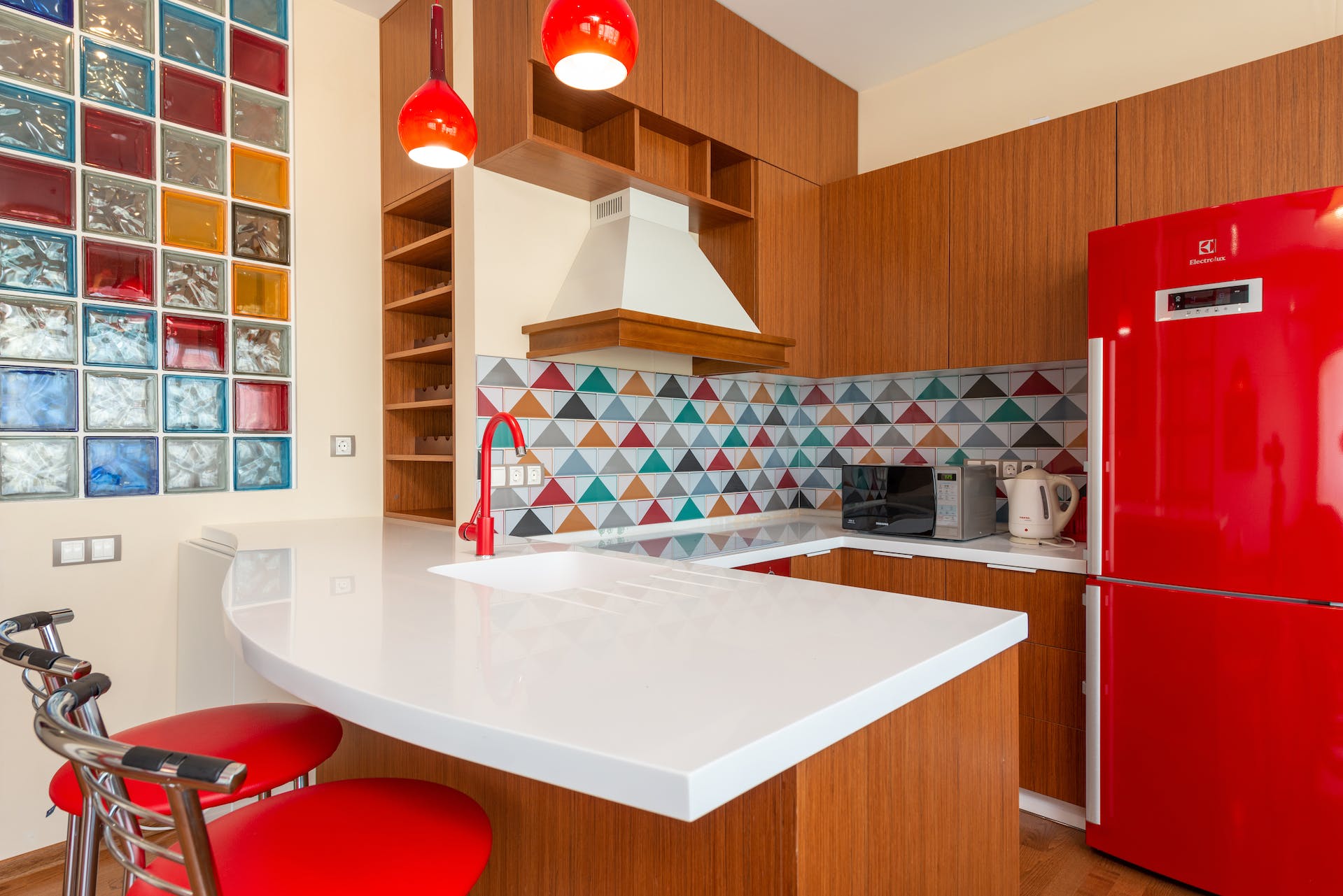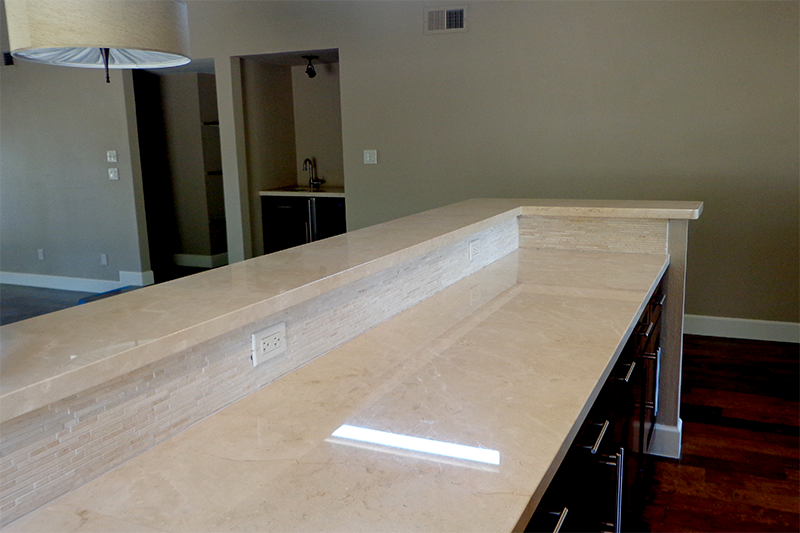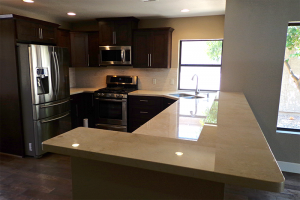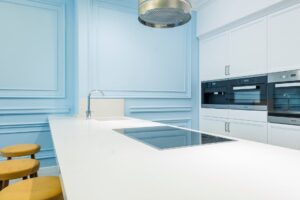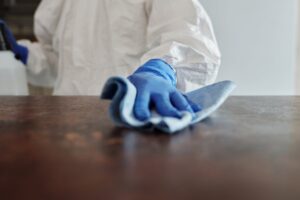Marble countertops are natural stone surfaces commonly used in kitchens and bathrooms for their timeless elegance and durability. Marble is a metamorphic rock primarily composed of calcite, dolomite, or serpentine minerals, and it forms through the crystallization of limestone or dolostone over millions of years. This natural stone has been prized for its aesthetic appeal and versatility in various architectural and design applications.
How to Install Marble Countertops
Installing marble countertops is a delicate and precise process that typically requires professional assistance due to the weight and fragility of the stone. However, you can attempt a DIY installation if you have the necessary skills, tools, and experience. Here’s a general overview of the steps involved to install marble countertops effectively:
Tools and Materials You’ll Need:
- Marble countertops
- Plywood or MDF substrate
- Screws
- Sink and faucet (if applicable)
- Plywood support strips (optional)
- Plywood template (optional)
- Measuring tape
- Circular saw
- Jigsaw
- Carpenter’s level
- Silicone adhesive
- Drill and screwdriver bits
- Clamps
- Polishing equipment (for finishing edges)
- Safety equipment (gloves, safety glasses, dust mask)
Steps to Install Marble Countertops:
-
Measure and Template
Measure the dimensions of your cabinets accurately to ensure that your marble slab will fit correctly. Create a template on plywood if necessary. It should match the size and shape of the countertop.
-
Prepare the Base
Place a plywood or MDF substrate on top of your cabinets. Make sure it is level and securely fastened to the cabinet frames using screws. If needed, add plywood support strips under the substrate for extra stability.
-
Cut the Marble
Carefully cut the marble slab to match the template or cabinet dimensions using a circular saw or jigsaw with a diamond blade. Wear appropriate safety equipment, and make precise, slow cuts to avoid chipping or cracking.
-
Dry Fit
Place the cut marble slab onto the substrate to ensure it fits correctly and is level. Make any necessary adjustments to the substrate or marble if there are discrepancies.
-
Polish the Edges (Optional)
If you want a rounded or beveled edge profile, use polishing equipment to shape and smooth the edges of the marble.
-
Install Sink and Faucet (If Applicable)
If you’re installing an undermount sink or faucet, do so before attaching the marble. Follow the manufacturer’s instructions for these fixtures.
-
Apply Adhesive
Remove the marble slab and apply a high-quality silicone adhesive to the top of the substrate. Apply the adhesive evenly, leaving no gaps or air bubbles.
-
Position the Marble
Carefully lower the marble slab onto the adhesive, aligning it with the cabinets and the template, if used. Use clamps to hold the marble in place temporarily.
-
Secure the Marble
Use screws to secure the marble to the substrate from underneath. Be cautious not to overtighten and crack the marble.
-
Clean Excess Adhesive
Wipe away any excess adhesive that may have squeezed out from under the marble. Use a damp cloth or sponge for this task.
-
Seal the Seams
If you have multiple marble slabs or seams, apply a seam filler or epoxy that matches your marble’s color. Sand the filled seams flush with the surface for a seamless appearance.
-
Final Adjustments
Check that the marble is level and secure. Make any necessary adjustments to ensure a perfect fit.
-
Finish and Seal
Polish the marble surface to your desired finish and apply a high-quality sealer to protect the marble and prevent staining.
-
Reconnect Plumbing
If you removed plumbing fixtures, reconnect them, ensuring they are appropriately sealed and functional.
-
Clean and Maintain
Regularly clean and maintain your marble countertops to preserve their beauty and longevity. Use pH-neutral cleaning products, avoid acidic substances, and reseal as needed.
It can be a challenging and precise task to install marble countertops, and it’s crucial to take your time and follow best practices to achieve a successful and visually appealing result. If you’re unsure about any aspect of the installation process, it’s advisable to consult a professional installer to ensure a flawless finish.
Characteristics of Marble Countertops
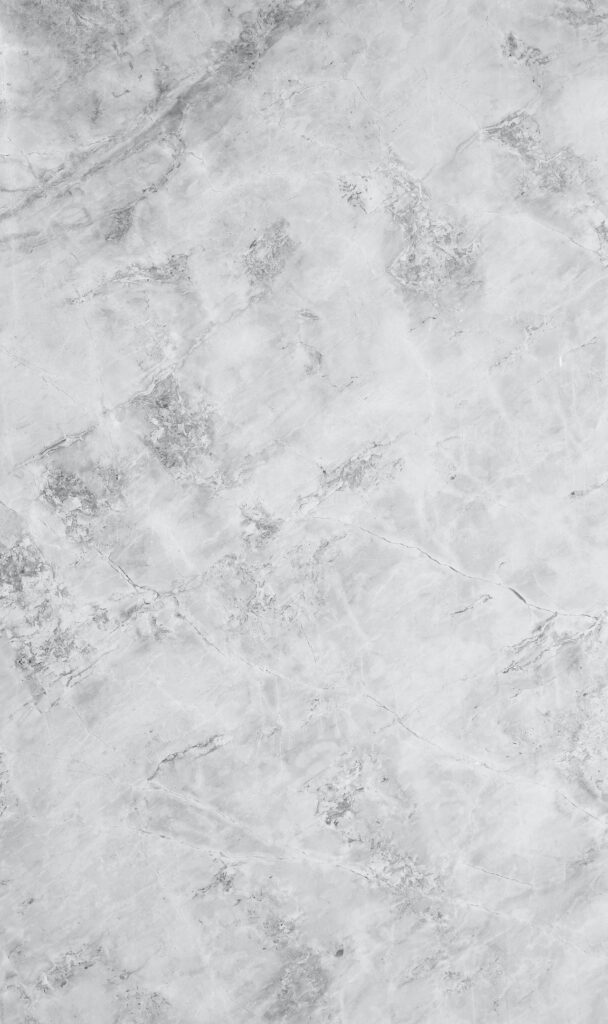 Here are some key characteristics and advantages of marble countertops:
Here are some key characteristics and advantages of marble countertops:
- Elegant Appearance: Marble countertops are renowned for their luxurious and sophisticated appearance. They have a distinctive veined pattern that adds a touch of natural beauty, elegance, and uniqueness to any space.
- Variety of Colors: Marble comes in a wide array of colors, from classic white and gray to more exotic hues like green, pink, and black. This diversity allows homeowners and designers to choose the perfect shade to match their interior design.
- Cool Surface: Marble countertops have a cool, smooth surface that is ideal for working with pastry and baking. This characteristic makes them a popular choice in kitchens, particularly for making dough.
- Heat Resistance: While marble can withstand high temperatures, it is essential to use hot pads or trivets to protect it from direct heat exposure, as extreme heat can cause discoloration or damage over time.
- Durability: Marble countertops can last a lifetime when properly cared for. They are resistant to scratches and cuts from knives but are more susceptible to chipping and staining than some other natural stones, such as granite.
- Natural and Unique: Each marble slab is one of a kind due to the natural variations in color, veining, and patterns. This uniqueness adds character to your space.
- Easy to Clean: Marble countertops are relatively easy to clean with just water and mild soap. Avoid using potent chemicals or abrasive cleaners, as they can damage the surface.
- Ages Gracefully: Marble develops a patina over time, giving it a lived-in, classic appearance that many homeowners find appealing.
Despite these advantages, it’s essential to be aware of the potential disadvantages of marble countertops:
- Porosity: Marble is a porous stone, which means it can absorb liquids and be prone to staining. It would be best to clean up spills promptly to prevent staining.
- Scratches and Etching: While it is resistant to scratches from utensils, it can still develop fine surface scratches over time. Additionally, acidic substances (like citrus or vinegar) can cause etching, which appears as dull spots on the surface.
- Maintenance: Marble countertops require regular sealing to reduce their susceptibility to staining and damage. The frequency of sealing depends on the type of marble and its usage.
- Cost: High-quality marble can be relatively expensive compared to other countertop materials, and installation costs can vary.
When considering marble countertops, it’s essential to weigh these limitations against the benefits and determine if the material aligns with your lifestyle and maintenance preferences. While marble’s beauty and elegance are undeniable, it may require more care and maintenance to keep it looking its best compared to other countertop materials.
Marble countertops are a timeless choice for homeowners and designers seeking a combination of natural beauty and functionality. Proper maintenance and care can help preserve their appearance and durability, making them a valuable addition to any kitchen or bathroom.
Why You Should Install Marble Countertops
Marble countertops offer several benefits, making them a popular choice for kitchen and bathroom surfaces. Here are some of the advantages if you install marble countertops:
-
Timeless Elegance
Marble is renowned for its classic and timeless appearance. Its natural veining and patterns add a touch of sophistication and beauty to any space, making it a sought-after material for interior design.
-
Variety of Colors
Marble comes in a wide array of colors, from white and gray to more vibrant hues like green, pink, and black. This diversity allows homeowners and designers to choose the perfect shade to match their interior décor.
-
Cool Surface
Marble countertops have a naturally cool surface, ideal for pastry and baking activities. This characteristic makes them a favorite choice in kitchens, especially for those who love to bake.
-
Heat Resistance
While marble can withstand high temperatures, it is essential to use trivets or hot pads to prevent exposing the surface to direct heat. This trait makes it suitable for kitchens where hot pots and pans are frequently used.
-
Durability
Marble countertops can last a lifetime when properly cared for. They are resistant to scratches and cuts from knives, which is a crucial advantage in the kitchen.
-
Natural and Unique
Each marble slab is unique because of the natural variations in color, veining, and patterns. This uniqueness adds character and a sense of luxury to your space.
-
Easy to Clean
Marble countertops are relatively easy to wipe with mild soap and water. It makes maintenance straightforward, and you can keep the surface looking pristine with minimal effort.
-
Ages Gracefully
Marble develops a patina over time, giving it a lived-in, classic appearance that many homeowners find appealing.
-
Increase Home Value
The presence of marble countertops can increase the resale value of your home. Potential buyers often view marble as a high-end, desirable feature.
-
Natural Material
Marble is a natural stone – which appeals to those who prefer environmentally friendly and sustainable building materials.
Despite these advantages, it’s crucial to be aware of the potential disadvantages of marble countertops, such as porosity, susceptibility to staining, and the need for regular sealing and maintenance. However, for many homeowners, marble’s aesthetic appeal and timeless elegance outweigh these considerations, making it a favored choice for countertops and other interior surfaces.
Maintaining Marble Countertops
Maintaining marble countertops is essential to preserve their natural beauty and durability. Marble is a porous stone, which makes it susceptible to staining, etching, and wear over time. However, with adequate and proper care and maintenance, you can keep your marble countertops looking pristine for years. Here’s a guide on how to maintain marble countertops:
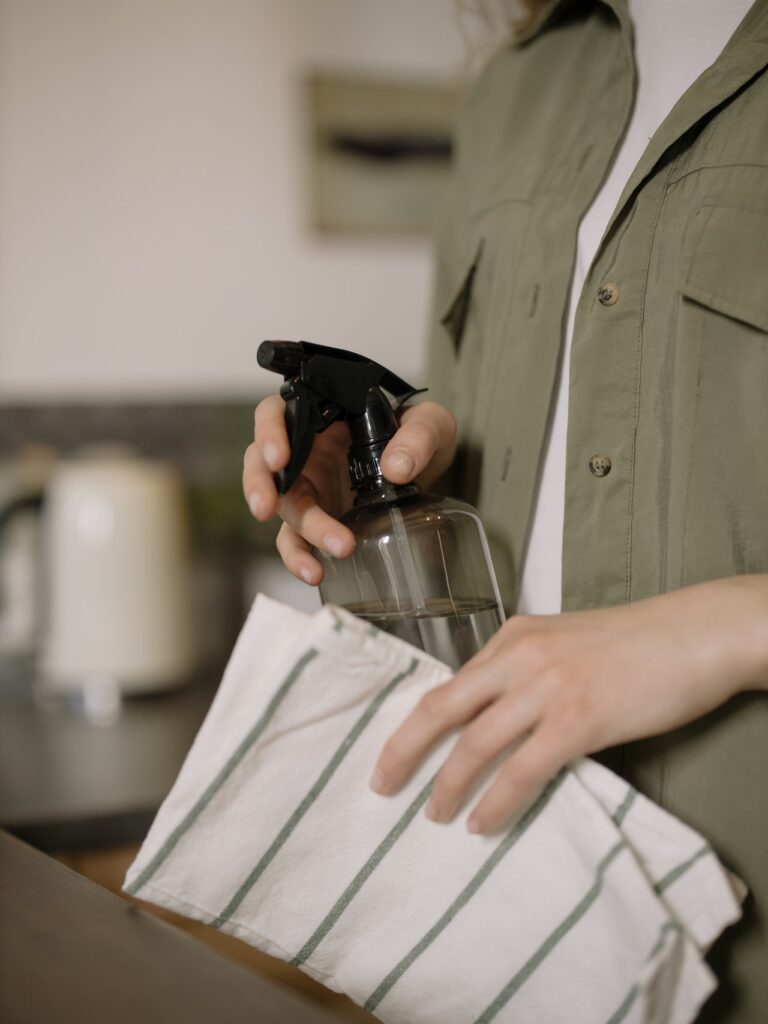 Daily Care:
Daily Care:
- Wipe Spills Promptly: Marble is susceptible to staining from acidic substances like citrus juices, wine, and vinegar. Quickly wipe up any spills with a clean, damp cloth or paper towel to prohibit staining.
- Use Mild Cleaning Products: Clean your marble countertops with a pH-neutral, non-abrasive cleaner or a solution of warm water with a few dish soap drops. Avoid using acidic or abrasive cleaners to prevent damaging the surface.
- Avoid Harsh Scrubbing: Use a soft cloth or sponge rather than abrasive scrubbers or steel wool pads when cleaning. Gently wipe the surface to prevent scratching.
- Dry Thoroughly: After cleaning or wiping down your countertops, dry them thoroughly with a clean, dry cloth to prevent streaks or water spots.
Regular Maintenance:
- Sealing: Marble is porous and can absorb liquids, which may lead to staining. To protect your marble countertops, apply a high-quality marble sealer recommended by your stone supplier. The sealing frequency depends on the marble type and usage but typically ranges from every six months to 1 year.
- Polishing: Polishing can help maintain the shine and luster of your marble countertops. Use a marble polishing powder or a specialized marble polishing product to restore the surface’s brilliance.
- Avoid Placing Hot Items Directly: While marble is heat-resistant, it’s best to use trivets or hot pads under hot pots, pans, and dishes to prevent thermal shock, which may lead to cracking or discoloration.
- Use Cutting Boards: Always use cutting boards when chopping or slicing food to prevent scratching and damage to your marble surfaces.
Preventing Etching:
- Be Mindful of Acids: Marble is sensitive to acidic substances, which can cause etching—a dulling of the surface. Avoid placing citrus fruits, vinegar, wine, and acidic cleaning products directly on the countertops. If an acidic spill occurs, clean it up immediately.
- Coasters and Mats: Use coasters under glasses and mats or placemats under dishes and utensils to protect the marble from etching and scratching.
Dealing with Stains:
- Blot Stains: If a stain does occur, blot it promptly with a clean cloth or paper towel. Avoid rubbing, as this spreads the stain.
- Gently Clean: For stubborn stains, create a poultice by mixing baking soda and water paste. Apply the mixture to the stain, then cover with plastic wrap and leave it overnight. Rinse and wipe clean in the morning.
- Consult a Professional: If stains persist or if you’re unsure about handling a particular stain, consult a professional stone restoration expert for assistance.
By following these care and maintenance recommendations, you can enjoy the beauty of your marble countertops for years to come. Remember that marble is a natural stone with unique characteristics; proper maintenance is essential to keep it looking its best.
Get Professional Installation
Marble countertop installation can be a challenging task, but you don’t have to go through so much for it. If you want to install your marble countertops effectively and ensure their longevity, it would be best to get professional countertop installers to do the job. The professionals from Granite Dude would be more than happy to provide you with the best installation work. Contact us today!

